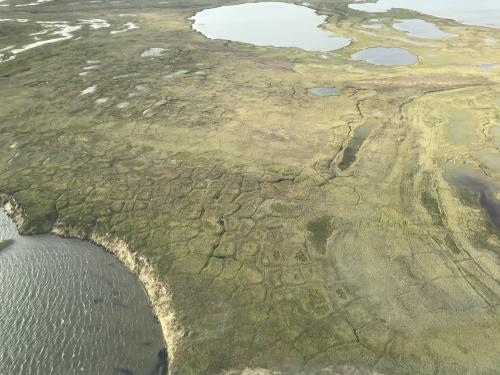...is this your first visit to my journal? Start on Day 1! Don't worry, we'll wait till you get back.
I know you've all be anxiously waiting for the answers to the quiz! Here we go:
PermafrostPermanently frozen ground. is a subsurface layer that remains frozen for two or more consecutive years (Question #1: C).
PermafrostPermanently frozen ground. is located at high altitudes in the Northern Hemisphere, including Alaska, Canada, Siberia, Greenland, Norway and Finland, isolated high elevation landscapes in the U.S. Rocky Mountains, Mount Kilimanjaro in Tanzania, and Hawaii’s Mauna Kea (Question #2: all of the above).
When permafrost thaws in Arctic environments, water stored in ice is released, initially resulting in wetter soil environments; the ground height subsides, leading to collapse of the soil and possible damage to roads, buildings and other human infrastructure; stored soil carbon becomes vulnerable to decomposition by soil microbes, and greenhouse gas emissions to the atmosphere can increase following the availability of new, non-frozen carbon (Question #3: all of the above).
TundraA treeless area between the icecap and the tree line of arctic regions, having a permanently frozen subsoil and supporting low-growing vegetation such as lichens, mosses, and stunted shrubs. is a type of biome where tree growth is limited by low temperatures and short growing seasons; permafrost affected vegetation that can include dwarf shrubs, mosses, lichens, sedges and grasses; and the name of an Alaska themed comic strip (Question #4 B, C, E).
ClimateThe average weather over a particular region of the Earth. Climate originates in recurring weather phenomenon that result from specific types of atmospheric circulation. change affecting Arctic landscapes in Alaska through a rise in average annual air temperatures by >3°F over the past 60 years, an increase more than double that observed in the mainland United States; the planned abandonment of Native coastal villages due to rising water; massive thaw of permafrost soils and melting of stored permafrost ice; the creation of new thermokarst lakes in areas experiencing initial permafrost thaw; and finally the disappearance of lakes in areas experiencing more severe and prolonged permafrost thaw (Question #5 all of the above).
Now think back to some of the photos you saw from the previous journal. In these pictures you were seeing some of the visible effects of permafrost thaw on Alaskan geography and vegetation – the accumulation of water, raising and lowering of land, and changes in vegetation.
Further Reading
Want to know more? Check out National Geographic's recent article on permafrost.
Today's 360 Image
This 360 image will help you visualize some of the landscape changes mentioned in the quiz. Scroll around! Tomorrow I'll be talking more about what Mariana and I are doing out on the tundra.


Comments